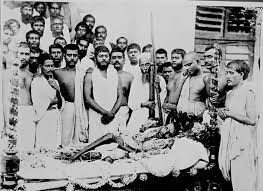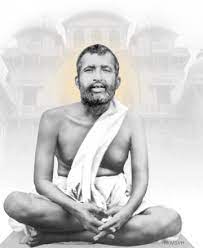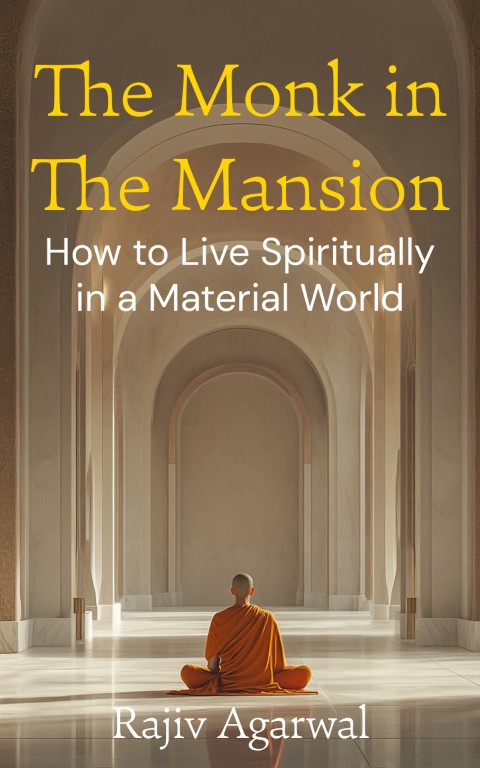
Ramakrishna Paramhansa Death & Life
What was the real name of Swami Ramakrishna Paramhansa?
Swami Ramakrishna Paramhansa was born as Gadadhar Chattopadhyay on 18 February 1836 in the village of Kamarpukur, West Bengal, India. His birth took place in a poor but religious Brahmin family. His parents, Khudiram Chattopadhyay and Chandramani Devi, were devoted to Hindu traditions, which deeply influenced his early years.
From a young age, Gadadhar showed a strong inclination toward spirituality. He disliked formal education but was deeply drawn to Hindu scriptures, bhajans, and temple rituals. His natural devotion and mystical experiences led him to become a priest at the Dakshineswar Kali Temple. Over time, people started recognising him as Ramakrishna Paramhansa, a revered spiritual leader who inspired figures like Swami Vivekananda.
How did Ramakrishna Paramhansa die?
Ramakrishna Paramhansa died on 16 August 1886 at the Cossipore Garden House, near Kolkata, India. In his final years, he suffered from a severe illness that progressively worsened. Despite his condition, he continued guiding his disciples and encouraging them to spread spirituality and serve humanity. His most devoted follower, Swami Vivekananda, and other disciples cared for him during his last days.
Even as his health deteriorated, Ramakrishna remained devoted to his spiritual mission. His followers believed he attained Mahasamadhi, a state of final liberation, upon his death. His passing deeply impacted his disciples, inspiring them to establish the Ramakrishna Math and Mission, which became a global force in spiritual education and social service.
What type of cancer did Ramakrishna Paramhansa have?

Ramakrishna Paramhansa was diagnosed with throat cancer, which eventually led to his death in 1886. His symptoms first appeared as difficulty in swallowing and throat pain, which worsened over time. Despite medical treatments, his condition deteriorated, and doctors were unable to cure him. He refused strong medication, believing that his suffering was part of divine will.
As his illness progressed, his disciples, including Swami Vivekananda, moved him to the Cossipore Garden House, where they provided care. Even in his weakened state, he continued guiding his followers, inspiring them to dedicate their lives to spirituality and selfless service. His illness was seen as a sacrifice, reinforcing his teachings about detachment from the physical body and focus on spiritual enlightenment.
What are the key events in the life of Ramakrishna Paramhansa?
Several key events shaped the life of Ramakrishna Paramhansa, starting with his birth in 1836 in Kamarpukur, West Bengal. His deep spiritual inclination emerged early, and he became the priest of Dakshineswar Kali Temple in 1855. There, he experienced divine visions, which strengthened his belief in the unity of all religions. He practised various spiritual paths, including Hinduism, Islam, and Christianity, proving his philosophy that all religions lead to the same truth.
In the 1870s, he met Narendranath Datta, who later became Swami Vivekananda and spread his teachings worldwide. His influence led to the formation of the Ramakrishna Order, which continues his work in spirituality and social service. His final years were marked by illness, yet he remained devoted to his disciples. After his passing in 1886, his followers established the Ramakrishna Mission, which continues to promote education, healthcare, and spiritual upliftment.
Which are the most famous books on Sri Ramakrishna?
Several books have been written about Sri Ramakrishna, documenting his life, teachings, and spiritual journey. One of the most famous is “The Gospel of Sri Ramakrishna” by Mahendranath Gupta (M), which captures his conversations and teachings in a diary format. Another well-known book is “Sri Ramakrishna: The Great Master” by Swami Saradananda, a detailed biography written by one of his direct disciples.
Other notable books include “Ramakrishna and His Disciples” by Christopher Isherwood, which presents his life from a Western perspective, and “The Life of Ramakrishna” by Romain Rolland, a biography by the Nobel laureate. These books offer deep insights into his philosophy, spiritual experiences, and influence on figures like Swami Vivekananda.
What is the best book to read about Ramakrishna’s life and philosophy?
The best book to read about Sri Ramakrishna’s life and philosophy is “The Gospel of Sri Ramakrishna” by Mahendranath Gupta. It provides an intimate, firsthand account of his teachings and daily interactions, making it a must-read for spiritual seekers. For a detailed biography, “Sri Ramakrishna: The Great Master” by Swami Saradananda offers in-depth insights into his life, mystical experiences, and spiritual legacy.
For Western readers, “Ramakrishna and His Disciples” by Christopher Isherwood presents his story in a compelling narrative style. “The Life of Ramakrishna” by Romain Rolland gives a historical and philosophical perspective. Each of these books captures different aspects of his spiritual philosophy, making them valuable resources for understanding his impact.
Are there any books written by Ramakrishna Paramahamsa himself?
Sri Ramakrishna Paramhansa did not write any books himself. He was not formally educated and preferred oral teachings, using parables and stories to convey deep spiritual truths. His words and conversations were recorded by disciples, leading to the creation of books like “The Gospel of Sri Ramakrishna” by Mahendranath Gupta.
His teachings were also compiled in works such as “Sayings of Sri Ramakrishna” and “Teachings of Sri Ramakrishna”. These books faithfully document his wisdom, making his philosophy accessible to readers worldwide. His disciples, especially Swami Vivekananda, played a key role in spreading his message through their writings and speeches.
What did Ramakrishna Paramhansa teach about karma?
Sri Ramakrishna taught that karma (action) determines one’s destiny and spiritual progress. He explained that good actions lead to spiritual growth, while selfish or harmful actions bind the soul to the cycle of birth and rebirth (samsara). He emphasised that performing one’s duties selflessly, without attachment to results, purifies the mind and leads to liberation.
He often used simple stories to illustrate karma. He compared worldly desires to seeds that eventually grow into consequences, teaching that pure devotion (bhakti) and surrender to God can dissolve past karma. He also believed that selfless service (karma yoga), performed with a pure heart, brings one closer to the divine. His disciple Swami Vivekananda later expanded on these ideas in his teachings on karma yoga.
What are the key teachings of Sri Ramakrishna?

Sri Ramakrishna’s teachings focused on God-realisation, religious harmony, and devotion. He believed that all religions lead to the same truth, comparing them to different paths leading to the same goal. He practised Hinduism, Islam, and Christianity, proving that divine realisation transcends religious boundaries.
He also taught that pure love and devotion (bhakti) are the simplest ways to experience God. He encouraged seekers to surrender completely to their chosen deity and develop an intimate relationship with the divine. His philosophy included Karma Yoga (selfless action), Jnana Yoga (path of knowledge), and Raja Yoga (meditation and discipline), stating that different people resonate with different paths. His teachings inspired the formation of the Ramakrishna Mission, which promotes spiritual practice and social service.
What is the Sri Ramakrishna Mission, and what does it do?
The Sri Ramakrishna Mission is a spiritual and charitable organisation founded by Swami Vivekananda in 1897 to spread the teachings of Sri Ramakrishna Paramhansa. It focuses on spiritual growth, education, healthcare, and social service, promoting the idea of service to humanity as worship of God. The mission follows the principles of Vedanta, emphasising selfless service, religious harmony, and personal spiritual development.
The organisation runs schools, colleges, hospitals, and relief programs worldwide. It provides free education to underprivileged children, operates hospitals and dispensaries, and offers disaster relief and rural development programs. The Ramakrishna Math, a monastic order associated with the mission, helps spread his spiritual message through meditation centres and publications. Its headquarters is in Belur Math, West Bengal, and it has branches across India and abroad.
Where is the Totapuri Ashram located?
The Totapuri Ashram is located in Puri, Odisha, India. It is named after Totapuri Maharaj, the Advaita Vedanta monk who was the guru of Sri Ramakrishna Paramhansa. Totapuri guided Ramakrishna in the practice of non-dual meditation (nirvikalpa samadhi), helping him experience Advaita Vedanta’s philosophy of oneness with the absolute Brahman.
The ashram serves as a spiritual retreat where seekers meditate and study Vedantic teachings. It is considered a sacred site for those interested in monastic life and deep meditation. The place is visited by devotees and scholars who want to understand the Advaita tradition that influenced Sri Ramakrishna’s spiritual journey.
Did Ramakrishna Paramahamsa eat fish?
Yes, Sri Ramakrishna Paramahamsa ate fish. Being a Bengali Brahmin, he followed the traditional diet of his region, where fish was commonly consumed. However, as a deeply spiritual person, he lived a simple and sattvic lifestyle, focusing more on devotion and self-discipline rather than rigid dietary rules.
His approach to food was non-dogmatic, and he often advised people to follow a diet suited to their health and environment. He believed that true spirituality comes from inner purity, not just external rules about food. While he consumed fish, his focus remained on spiritual realisation and devotion to Goddess Kali.
Who was the guru of Ramakrishna Paramhansa?
Sri Ramakrishna Paramhansa had multiple spiritual teachers. His Advaita Vedanta guru was Totapuri, a wandering monk who taught him non-dual meditation (nirvikalpa samadhi). Under Totapuri’s guidance, Ramakrishna realised the concept of Brahman as the formless absolute.
Another significant guru was Bhairavi Brahmani, a female Tantric monk who guided him in Tantric and Bhakti practices. She recognised him as a divine incarnation and helped him navigate intense spiritual experiences. He also practised Islam and Christianity under the guidance of different teachers, proving his belief in the unity of all religions.
Who was Ramakrishna’s wife?
Sri Ramakrishna’s wife was Sarada Devi, whom he married at the age of six, following traditional customs. However, their marriage was spiritual rather than conventional. When Sarada Devi grew up and joined him at Dakshineswar, Ramakrishna revered her as the embodiment of the Divine Mother rather than treating her as a regular wife.
Sarada Devi later became known as “Holy Mother” and played a key role in continuing Ramakrishna’s teachings. She guided disciples, led a simple life of service, and inspired the formation of the Ramakrishna Mission. Her influence made her an important spiritual figure in her own right.
What did Ramakrishna say about sex?
Sri Ramakrishna viewed sex and lust (kama) as obstacles on the path to spiritual enlightenment. He often described desire for wealth and sensual pleasures (kamini-kanchana) as distractions that keep the mind attached to the material world. He believed that true devotion requires purity of heart and detachment from bodily desires.
However, he did not advocate suppression but transformation of desires into devotion. He encouraged householders to live a moral life but also advised monks to practise complete celibacy (brahmacharya). His own life was an example of this, as he treated his wife Sarada Devi with the highest spiritual reverence.
Did Ramakrishna see Kali?
Yes, Sri Ramakrishna claimed to have seen Goddess Kali in a living, divine form. As the priest of the Dakshineswar Kali Temple, he worshipped her with intense devotion. At one point, unable to bear separation from the divine, he experienced a vision of Kali as a living goddess, full of light and infinite love.
He described her as a motherly, compassionate presence, and these visions continued throughout his life. This experience reinforced his belief that God can be realised through deep love and surrender. His encounters with Kali Ma became the foundation of his teachings on Bhakti (devotional) spirituality.
What was Swami Ramakrishna’s age when he died?
Sri Ramakrishna Paramhansa passed away on 16 August 1886, at the age of 50. He had been suffering from throat cancer, which gradually worsened. Despite his illness, he continued guiding his disciples until his last days at the Cossipore Garden House near Kolkata.
His death marked the beginning of the Ramakrishna Order, as his disciples, led by Swami Vivekananda, took his teachings to the world. His legacy continues through the Ramakrishna Math and Mission, which spreads his message of spirituality and selfless service.
Who was Vivekananda’s guru?
Swami Vivekananda’s guru was Sri Ramakrishna Paramhansa. Their first meeting in 1881 changed Vivekananda’s life. Initially sceptical, Vivekananda (then Narendranath Datta) questioned Ramakrishna about whether he had seen God. Ramakrishna replied, “Yes, I have seen Him, just as I see you, only more clearly.”
This encounter deeply impacted Vivekananda, and he later became Ramakrishna’s most famous disciple. After Ramakrishna’s death, he took his master’s message to the world, spreading Vedanta and spiritual awakening. His efforts led to the founding of the Ramakrishna Mission, which continues to inspire seekers globally.

